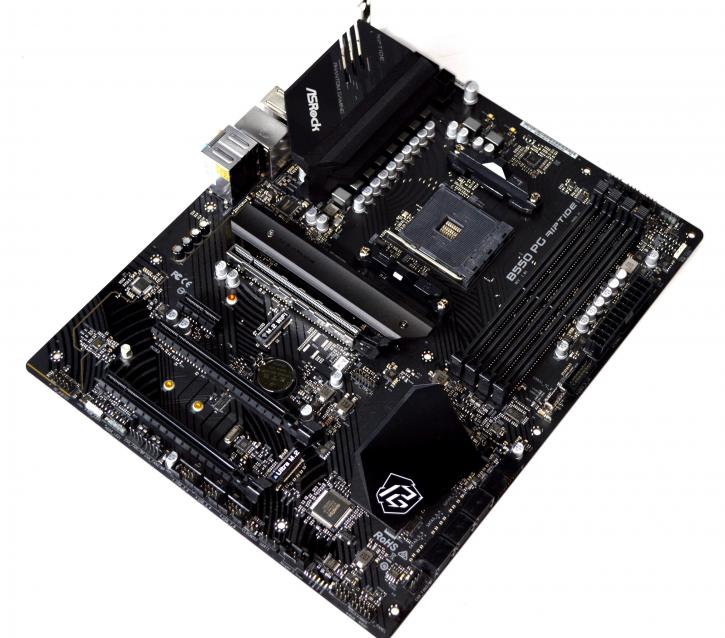Final Words & Conclusion
Conclusion
In terms of product anticipation, the Asrock B550 PG RIPTIDE was perhaps not one of the most highly anticipated products on the market. Asrock has already released a number of models that are part of the B550 series. Was it absolutely necessary? We don't mind having more options because it's a welcome addition, thus we can't complain about having more options. This board should find a niche in which to operate. The RGB enthusiasts will receive two addressable and two standard LED strip headers - there isn't much to complain about in terms of selection. The DDR4 memory slots have a capacity of up to 128 GB. This motherboard is also capable of supporting DDR4-4933 memory, which is fantastic but overkill. With only a single main PCIe 4.0 x16 slot, which is supported by the CPU, and two PCI 3.0 (full-length) slots (one of which is x4, the other of which is x1), as well as a PCIe 3.0 x1, the Asrock B550 PG RIPTIDE is a budget-friendly option. With the Realtek ALC897 codec, the audio on this board appears to be very, very old-fashioned. Wireless LAN (although there is a location for connecting antennas) and an integrated I/O shield are not included. On the other hand, you will find a 2.5 Gbps LAN as well as support for graphic cards that will keep your system from sagging. Additionally, there are a plethora of USB ports on the rear panel (ten in total! ), but none of them are USB 3.2 Gen2x2 compatible. The Asrock B550 PG RIPTIDE is priced at approximately 160 USD, making it a reasonably priced option. One PCIe 4.0 x4 drive and one PCIe 3.0 x4 drive can be installed in each of the M.2 slots. In general, the B550 is the best chipset for the Ryzen processor for the vast majority of customers. In addition, the board features an 8+2 VRM portion that is very acceptable.
DDR4 Memory
Memory compatibility should not and likely will not be an issue as long as you stick to recently released DIMMs. I’ll keep repeating this, but there are some really good Ryzen-optimized kits out there. With Ryzen Generation 3, you can go higher in DDR4 clock frequency if you want to. We’d say that up to 3600 MHz CL16 is fine. If you go beyond this value, a 2:1 divider kicks in (but you can achieve even 3733 or 3800 MHz with a bit of effort and luck). This, in turn, may affect Infinity Fabric bandwidth and inter-core CCX bandwidth. We see no reason for faster DDR4 memory anyways. It’s expensive and does not bring in added perf, as you can see in our Ryzen RAM gaming test. It’s better to have four banks occupied with double-sided memory.
Power consumption
With Ryzen 3000 processors fabbed at 7nm, you may see some interesting energy efficiency. We used an 8-core 3700X with this B550, which is adequate. The load values are admirable.
Performance & tweaking
This motherboard will not be a restriction for tweaking and overclocking. Processor and ASIC quality, alongside cooling, are the more important factors these days. The original Ryzen products from 2017 offered clocks in the 3900~4000 MHz range on all cores. Then, Ryzen 2000 / Zen+ brought it up a notch. Finally, the Ryzen 3000 seems to handle an all-core clock of 4300~4400 MHz at best. Our Ryzen 7 3700X reached a stable 4400 MHz, but that was done with proper liquid cooling, and it’s the absolute maximum. If you tweak to the limit, likely 1.425V~1.450V is needed for a stable 4.3 GHz on all cores. The thing is, and I have been thinking about this for a long time, I would not recommend overclocking and tweaking at all. These processors can boost 1 or 2 cores to 4500 or 4600 (even 4.7 GHz for the 16-core model). So, while the rest of the cores will be binned slower, that’s where you get your extra gaming performance. The positives of an all-core 4400 Mhz would not outweigh the positives of the default high Turbo clocks. It is something to think about for sure. At the very least, you can try and see what works best for you. However, the binned clock recipe that AMD has applied to these processors by default will likely work best in most aspects, including power consumption. This is going to be a generic and general consensus for all multi-core processors.
Final words
With the Asrock B550 PG Riptide, you get a single PCIe 4.0 for graphics (x16), two full-length PCIe 3.0 (one x4, the other x1), one PCIe 3.0, two M.2 slots, and the option to overclock the processor and graphics cards. The vast majority of consumers should be satisfied with this level of service. For this user base, the X570 is not worth the price premium over the X550. We should also point out that B450 motherboards were substantially less expensive; on the other hand, the vast majority of B550 products, including those in the VRM field, are extremely good. It should be able to handle even the 12-core Ryzen 9 3900X/5900X processors (although we wouldn't recommend it for the 16-core 3950X/5950X processors, for obvious reasons). The price is approximately 160 USD, which is quite reasonable for a B-series chipset of this caliber. On the back panel, you'll find a glorious 2.5 Gbps LAN jack, a total of 7 fan headers are onboard (which is quite excellent), and a plethora of USB ports (there are ten of them). In contrast, there's an ALC897 audio codec, no integrated I/O shield, and WiFi (as well as an antenna connection point! ). Additionally, the USB 3.2 Gen2x2 connector is not available, therefore you will not be able to achieve the greatest feasible performance. We would prefer to see something at the very least from the ALC 11xx series. To summarize, we are unable to grant anything higher than the "Approved" designation, but this is a very decent motherboard for the money.
Handy related downloads:
- Sign up to receive a notification when we publish a new article
- Or go back to Guru3D's front page



